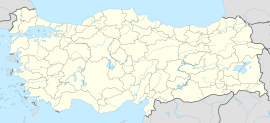Kösreli (Syriac: Ḥaṣṣen)[2][nb 1] is a village in the Silopi District of Şırnak Province in Turkey.[4] The village is populated by Assyrians and had a population of 43 in 2023.[1][5] It is located on Mount Judi.[6]
Kösreli | |
|---|---|
| Coordinates: 37°20′31″N 42°25′26″E / 37.342°N 42.424°E | |
| Country | Turkey |
| Province | Şırnak |
| District | Silopi |
| Population (2023)[1] | 43 |
| Time zone | UTC+3 (TRT) |
History
editThe Church of the East metropolitan bishop Joseph of Gazarta is attested to have resided at Ḥaṣṣen (today called Kösreli) in 1808 after he had been forced to abandon his normal residence at the Monastery of Mar Isaac of Nineveh due to war.[7] In this year, he copied a manuscript at the Church of Mar Mūshe at Ḥaṣṣen for a Christian woman called Alpō.[8] In a letter from the American mission at Urmia in 1877, they claimed to have converted the village's priest and it is mentioned in 1881 that it was inhabited by 25 Protestant families who had converted along with their bishop, as well as four or five families who adhered to the Church of the East.[9]
According to the list presented to the Paris Peace Conference by the Assyro-Chaldean delegation, Ḥaṣṣen was inhabited by 300 Assyrians in 1914, at which time they were tenants of the Aghas of Şırnak and Silopi.[10] Amidst the Sayfo, most of the villagers were massacred, including the Presbyterian pastor and the Church of the East priest, whilst some survivors found refuge at the nearby Kurdish village of Gerçulaye.[11] In 1918, the village was inhabited by 420 Assyrians.[12]
Ḥaṣṣen had two churches dedicated to Mart Shmuni and Mar Mikhaʾil respectively in the 1950s that may have been built prior to the First World War.[13] By 1980, it was inhabited by 200 Assyrian families, including adherents of the Assyrian Church of the East, the Chaldean Catholic Church, and the Syriac Orthodox Church.[14] Ḥaṣṣen was forcibly evacuated by the Turkish army on 20 November 1993, but 40 families remained, and some families temporarily moved to Midun, Azakh, Bnebil, and the Mor Hananyo Monastery.[15] Many villagers emigrated to Germany and Belgium, particularly the city of Mechelen.[16] The Turkish Ministry of National Defence authorised families to return to Ḥaṣṣen in 2010.[17]
Population
editPopulation history from 2015 to 2023:[1]
| Year | Pop. | ±% |
|---|---|---|
| 2015 | 26 | — |
| 2020 | 48 | +84.6% |
| 2023 | 43 | −10.4% |
Notable people
edit- Erol Dora (b. 1964), Assyrian politician
References
editNotes
Citations
- ^ a b c "Population Of Municipalities, Villages And Quarters". TÜİK. Retrieved 10 May 2024.
- ^ Wilmshurst (2000), p. 105.
- ^ Gaunt (2006), p. 224; Jongerden & Verheij (2012), p. 328.
- ^ "Türkiye Mülki İdare Bölümleri Envanteri". T.C. İçişleri Bakanlığı (in Turkish). Retrieved 19 December 2022.
- ^ Andrews & Benninghaus (1989), p. 384.
- ^ Wilmshurst (2000), p. 107.
- ^ Wilmshurst (2000), pp. 117, 119.
- ^ Wilmshurst (2000), p. 119.
- ^ Wilmshurst (2000), pp. 105, 119.
- ^ Gaunt (2006), pp. 224, 426.
- ^ Gaunt (2006), p. 224.
- ^ Yacoub (2016), p. 197.
- ^ Wilmshurst (2000), p. 120.
- ^ Atto (2011), p. 139; Courtois (2013), p. 150.
- ^ Atto (2011), p. 139.
- ^ Atto (2011), p. 140; Courtois (2013), p. 150.
- ^ Courtois (2013), p. 150.
Bibliography
edit- Andrews, Peter Alfred; Benninghaus, Rüdiger (1989). Ethnic Groups in the Republic of Turkey. Reichert.
- Atto, Naures (2011). Hostages in the Homeland, Orphans in the Diaspora: Identity Discourses Among the Assyrian/Syriac Elites in the European Diaspora (PDF). Leiden University Press. Retrieved 27 December 2019.
- Courtois, Sébastien de (2013). "Tur Abdin : Réflexions sur l'état présent descommunautés syriaques du Sud-Est de la Turquie,mémoire, exils, retours". Cahier du Gremmamo (in French). 21: 113–150.
- Gaunt, David (2006). Massacres, Resistance, Protectors: Muslim-Christian Relations in Eastern Anatolia during World War I. Gorgias Press. Retrieved 21 May 2023.
- Jongerden, Joost; Verheij, Jelle (2012). Social Relations in Ottoman Diyarbekir, 1870-1915. Brill.
- Wilmshurst, David (2000). The Ecclesiastical Organisation of the Church of the East, 1318–1913. Peeters Publishers.
- Yacoub, Joseph (2016). Year of the Sword: The Assyrian Christian Genocide, A History. Translated by James Ferguson. Oxford University Press.
